#army of the potomac
Text

“Lions of Little Round Top, July 2nd 1863″
Painting by Don Troiani
Late in the afternoon of July 2, 1863, on a boulder-strewn hillside in southern Pennsylvania, Union Colonel Joshua Lawrence Chamberlain dashed headlong into history, leading his 20th Maine Regiment in perhaps the most famous counterattack of the Civil War.
The regiment’s sudden, desperate bayonet charge blunted the Confederate assault on Little Round Top and has been credited with saving Major General George Gordon Meade’s Army of the Potomac, winning the Battle of Gettysburg and setting the South on a long, irreversible path to defeat.
#gettysburg#little round top#joshua chamberlain#army of the potomac#civil war#pennsylvania#painting#artwork#art#military#history
29 notes
·
View notes
Text

The 8th Ohio Volunteer Infantry Regiment was raised in Cleveland, Ohio, in response to President Abraham Lincoln's 1861 call for 75,000 to put down the rebellion. Initially the regiment was supposed to serve for only three months. However, many of its members reenlisted for three years of service and so the regiment would continue to exist until 1864.
It's most famous moment was during the 3rd day of the battle of Gettysburg, when the regiment was placed ahead of the Union line at Cemetery ridge. At this position they were able to fire upon the left flank of Brockenbrough's during (the misnamed) Pickett's charge.
Featuring: @temper-temper
#temper-temper#FairChild#Art#Random Art#MLP#My Little Pony#History#American History#American Civil War#8th Ohio Volunteer Infantry Regiment#Union Army#Army of the Potomac#Now this made me realize how hard it would be to load a rifled-musket with just hooves#Also#temper I know you're reading this#and I know you said to stop showering you with gift art#But I choose to ignore that and instead shower you with more gift art
19 notes
·
View notes
Text

A Rainy Day in Camp, Winslow Homer, 1871 (original study April-May 1862)
#art#art history#Winslow Homer#genre painting#Civil War#American Civil War#Army of the Potomac#American art#19th century art#Metropolitan Museum of Art
46 notes
·
View notes
Photo


Group of officers [Capt. Pierce, Capt. Page, Capt. Howell, Lt. Kelly] Headquarters, Army of the Potomac (Culpeper, Virginia) (x) (x)
#american civil war#us civil war#civil war#timothy o'sullivan#army of the potomac#just my dudes chilling at hq#acw#history
30 notes
·
View notes
Text
The largest massacre of Black soldiers by Confederate soldiers was in the Battle of the Crater:
The biggest massacre of Black soldiers in the war was in the Battle of the Crater. Part of the Siege of Petersburg, the war's longest campaign and the one where it really did start to foreshadow the war of 1914 (and ironically the one campaign of which the least is written about in spite of being both the longest and the most modern for a variety of reasons), it was the most ill-starred battle of the campaign. It saw a plan that could have worked bungled by Burnside, Mead, and Grant.
The plan was to do a very medieval method of breaking a siege and a very unsubtle one. Blow a hole in the line, advance around the hole, roll the line up. The plan was assigned to Black soldiers, then Mead got cold feet, talked Grant and Burnside into changing this, and the plan that unfolded was a prime example of how to kill a lot of people in a short amount of time for no gain. The troops originally assigned were drawn into the killing field in the Crater because the white troops that replaced them forced the battle there.
General William Mahone, a future pro-civil rights 'Readjustor' orchestrated accordingly the largest massacre of Black soldiers in the entire war, one done by Lee's Army of Northern Virginia and one noted at the time. Leading to the grim irony that General Mead's racism brought about the very thing he claimed he didn't want.
#lightdancer comments on history#black history month#war of the rebellion#battle of the crater#siege of petersburg#army of the potomac#army of northern virginia#black resistance#united states colored troops
2 notes
·
View notes
Text
1863 – The Battle of Chancellorsville




American Civil War: The Battle of Chancellorsville ends with the defeat of the Army of the Potomac by the Army of Northern Virginia.
#May.6.1863#Battle of Chancellorsville#Army of the Potomac#Army of Northern Virginia.#Joseph Hooker#Robert E. Lee#history today
0 notes
Text
Upton's Charge
Upton’s Charge
Spotsylvania Courthouse was one of the bloodiest battles of the American Civil War. Fought in Virginia from May 8-19, 1864, the Battle of Spotsylvania Court House casualties were at least 60,000 casualties. The Union army, led by General Ulysses S. Grant, attempted to march south towards the Confederate capital of Richmond. However, they were met by a Confederate force under General Robert E. Lee…
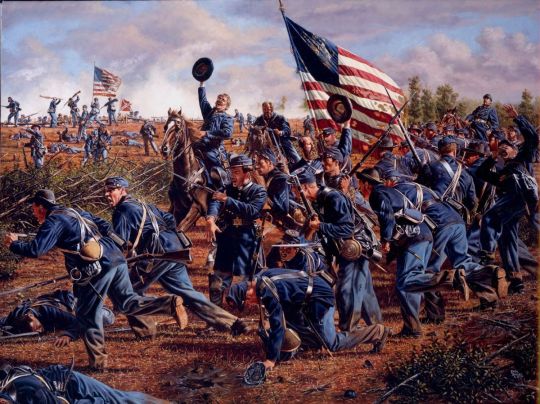
View On WordPress
0 notes
Text
Mike Farrells Bonanza character is actually going to be a problem for me oh no
#HE WAS IN THE ARMY OF THE POTOMAC ARE U KIDDING MEEEEEEE#that was probably the easiest one to give him in the show bc people are more likely to know that one over army of the Tennessee or the Ohio#but....#*rubbing my hands evilly bc i know where i can stick him*#i should have known i was done for when i headcanoned him in the VI corps#god help me either i rewrite his episode or i start writing my hawkeye civil war au whichever comes first
3 notes
·
View notes
Text
If any other country’s history required you to remember that the nation’s Good Guys and Bad Guys literally switched names and uniforms over one, specific, 5-10 year period*, I would make such fun of that country! And yet!
*with stragglers, I know! Don’t be pedantic!
#reading about partisan divides in the army of the Potomac#the noble Republicans eventually convinced their fellow soldiers to reject the wicked democrats#with lots of rousing speeches to this effect
72 notes
·
View notes
Photo
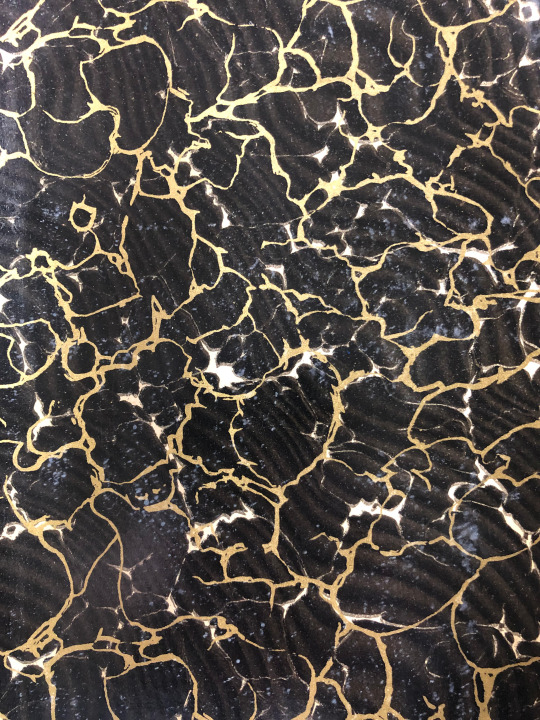
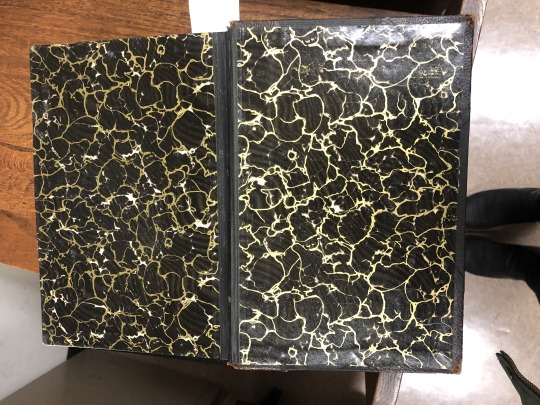
Marbled Monday
This lovely black and gold marbling comes from Memoirs of Milwaukee County, a book recounting Milwaukee County history from “the earliest historical times to the present, including a genealogical and biographical record of representative families in Milwaukee County.” Written by Jerome A. Watrous, this 2 volume set was published in 1909 by Western Historical Association of Madison, WI. Watrous served in the Iron Brigade of the Union Army of the Potomac during the Civil War and was a journalist and historian.
The marbling appears to be either a gold vein overprint or double marbling, meaning that the paper was either marbled once and then printed with gold veining using a lithographic process, or marbled again to create the gold veining. If you look closely at the first image, you can see a wavy pattern in the black and white marbling.
View more Marbled Monday posts.
-- Alice, Special Collections Department Manager
#Marbled Monday#Memoirs of Milwaukee County#Jerome A. Watrous#Iron Brigade#Union Army of the Potomac#Civil War#Milwaukee County History#History#Wisconsin History#marbling#gold veining#gold vein#overprint#double marbling
35 notes
·
View notes
Text
Everybody agreed that the Washington’s Birthday ball was the most brilliant event of the winter. Unlike most social functions in this army camp by the Rapidan, it was not held in a tent. There was a special, weatherproof ballroom—a big box of a building more than a hundred feet long, whose construction had kept scores of enlisted men busy. Some of these had been sent into the woods to fell trees. Others had taken over and operated an abandoned sawmill, to reduce the trees to boards. Still others, carpenters in some former incarnation, had taken these boards and built the building itself, and it was pleasantly odorous of new-cut pine, decorated with all of the headquarters and regimental flags which the II Army Corps possessed. The flags may have been worth seeing. It was the boast of this corps that although it had suffered nearly 19,000 battle casualties it had never yet lost a flag to the enemy.
A Stillness at Appomattox: The Army of the Potomac, Vol. 3
By Bruce Catton
#quotes#first lines#currently reading#history#civil war#military history#us history#american history#bruce catton#a stillness at Appomattox#the army of the Potomac#booknerd#bookstagram#booklr#book blog#bookworm#booklover
0 notes
Photo
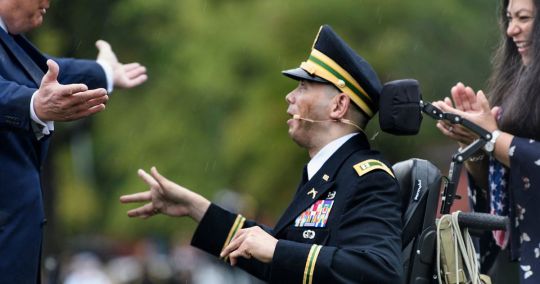
(via Trump Reportedly Said ‘No One Wants to See’ Wounded Vets)
At his welcome ceremony at Joint Base Myer–Henderson Hall, across the Potomac River from the capital, Milley gained an early, and disturbing, insight into Trump’s attitude toward soldiers. Milley had chosen a severely wounded Army captain, Luis Avila, to sing “God Bless America.” Avila, who had completed five combat tours, had lost a leg in an IED attack in Afghanistan, and had suffered two heart attacks, two strokes, and brain damage as a result of his injuries. To Milley, and to four-star generals across the Army, Avila and his wife, Claudia, represented the heroism, sacrifice, and dignity of wounded soldiers.
It had rained that day, and the ground was soft; at one point Avila’s wheelchair threatened to topple over. Milley’s wife, Hollyanne, ran to help Avila, as did Vice President Mike Pence. After Avila’s performance, Trump walked over to congratulate him, but then said to Milley, within earshot of several witnesses, “Why do you bring people like that here? No one wants to see that, the wounded.” Never let Avila appear in public again, Trump told Milley. (Recently, Milley invited Avila to sing at his retirement ceremony.)
donny has some real serious issues with disadvantaged people...
#donny#pretends the wounded service members don't exist#traitor to his country#in every way#politics
186 notes
·
View notes
Text

Timothy O'SUllivan Group of Officers of the Army of the Potomac, Outside Washington DC 1863
35 notes
·
View notes
Text
🎨Winslow Homer
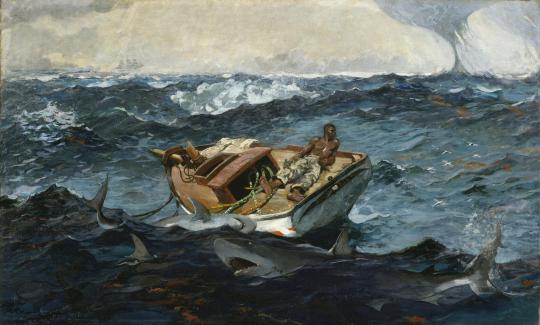
Winslow Homer | The Gulf Stream - 1899 - Metropolitan Museum of Art, New York City
The Gulf Stream shows a man in a small dismasted rudderless fishing boat struggling against the waves of the sea, and was the artist's statement on a theme that had interested him for more than a decade.
Chronologically the first of a series of major works painted by Homer in the last decade of his life, The Gulf Stream was painted in the penultimate year of the century, the year after the death of his father, and has been seen as revealing his sense of abandonment or vulnerability.

Winslow Homer | After the Hurricane - 1899
After the Hurricane, perhaps it's the sequel to The Gulf Stream, "is among Homer’s most astonishing and ambitious watercolors for its sheer technical virtuosity and epic subject matter"
An earlier painting 🔽
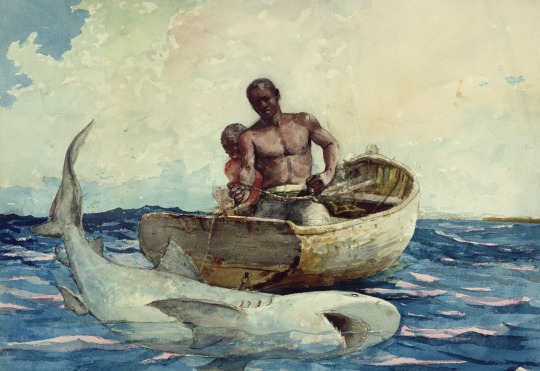
Shark Fishing - 1885

Homer in his studio. In 1859, he opened a studio in the Tenth Street Studio Building in New York City, the artistic and publishing capital of the United States.
Until 1863, he attended classes at the National Academy of Design, and studied briefly with Frédéric Rondel, who taught him the basics of painting. In only about a year of self-training, Homer was producing excellent oil work. His mother tried to raise family funds to send him to Europe for further study but instead Harper's sent Homer to the front lines of the American Civil War (1861–1865), where he sketched battle scenes and camp life, the quiet moments as well as the chaotic ones.

Winslow Homer - Prisoners from the Front - 1866 - now housed in the Metropolitan Museum of Art in New York City

Winslow Homer - Home, Sweet Home - 1863 - National Gallery of Art, Washington, D. C
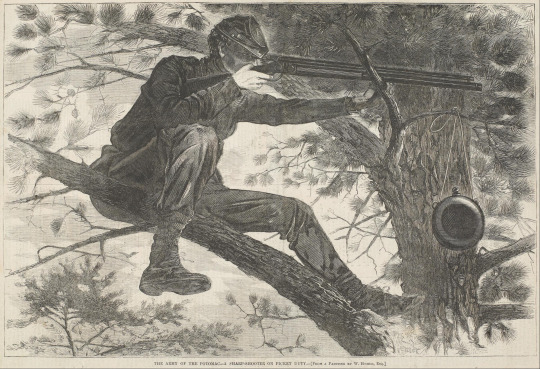
Winslow Homer - The Army of the Potomac - A 'Sharp-Shooter on Picket Duty' during the American Civil War - 1862 - wood engraving on paper. Smithsonian American Art Museum
#homer#winslow homer#After the Hurricane#vintage photography#art#paintings#The Gulf Stream#1899#artists#sharp shooter#civil war#potomac#Prisoners from the Front#Sharp-Shooter on Picket Duty
96 notes
·
View notes
Photo


Elisha Hunt Rhodes, eldest son of ship captain Elisha Hunt Rhodes and Eliza Ann (Chace) Rhodes, was born in Pawtuxet Village on March 21, 1842. This lineal descendant of Roger Williams attended schools in Cranston and Providence including Potter & Hammond’s Commercial College. His father’s death at sea when Elisha was only sixteen left him the sole supporter of his family. He left school to work as a clerk in the office of a mill supplier. When the Civil War erupted, he promptly enlisted as a private in Co.D, 2nd Rhode Island Volunteers . He remained in this unit from June 5, 1861 until it was disbanded on July 28, 1865 rising from the rank of private to that of colonel. Rhodes participated in every campaign of the Army of the Potomac from Bull Run to Appomattox, keeping a detailed diary of his war experiences. After the war Rhodes engaged in marketing cottons and woolens throughout the country, but his truly significant efforts still pertained to the military. He headed veterans organizations, organized reunions at various battlefields, and helped raise funds for monuments in battlefield parks. He served in the Rhode Island Militia becoming state adjutant general, and he was a founder and first president of the Soldiers’ and Sailor’s Historical Society of Rhode Island, a position that enabled him to continue his Civil War writings. Rhodes also engaged in political life serving in such posts as a member of the Providence School Board, assessor of taxes in Providence, and Collector of Internal Revenue for the District of Rhode Island. General Rhodes was an active Mason and a deacon and Sunday school superintendent at Providence’s Central Baptist Church. He died on January 14, 1917 at the age of seventy-five.
#elisha hunt rhodes#american civil war#us civil war#us history#army of the potomac#acw#history#if you can you gotta read his book called 'all for the union'#it's basically all his diary entries from the start to the end of the war#an awesome read#and he's very funny!#but it's great insight into the day to day of a soldier
15 notes
·
View notes
Photo

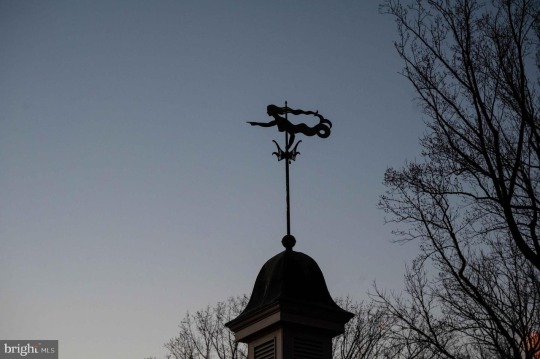
The Ross House was built beside the Potomac River in Bladensburg, Maryland in 1749 by Dr. David Ross, a surgeon in the Continental Army. During the War of 1812, it was used as a hospital for British and American soldiers. The home was carefully dismantled in 1957, but 22,000 bricks, windows, flooring, paneling , doors, and handmade nails were preserved for five years. In 1962, Leonard C. Crewe Jr. sought to build a colonial style home. He commissioned Bryden B. Hyde, a Baltimore-based architect and an officer for the Society for the Preservation of Maryland Antiquities, to design the home. Hyde suggested to Crewe to reconstruct a historic home instead. That’s how this wonderful historic home came to be in Cockeysville, Maryland. 6bd. 7ba. $1.8M.
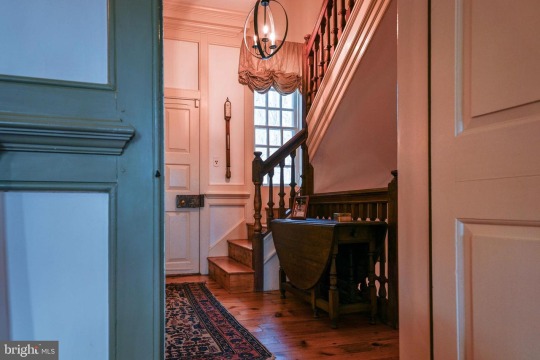
It’s a glorious Colonial home, yet some people insist that it’s haunted.

It’s been meticulously restored, even to the detail of adding oyster shells to the mortar to make it more authentic.



The formal dining room is spacious and has a lovely fireplace. The wood details are painted in authentic colors of the period.
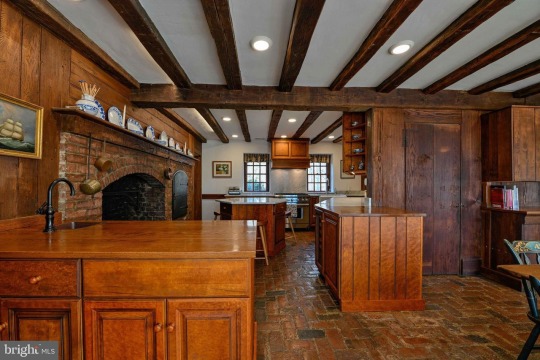
The kitchen is amazing. Not only is it huge, but it has the original hearth and brick oven.

Just look at this wall.

It can’t any more original than this.

The rooms are so spacious, I can see why it was used as a hospital. This is a lovely family room.


Very authentically restored bedroom.

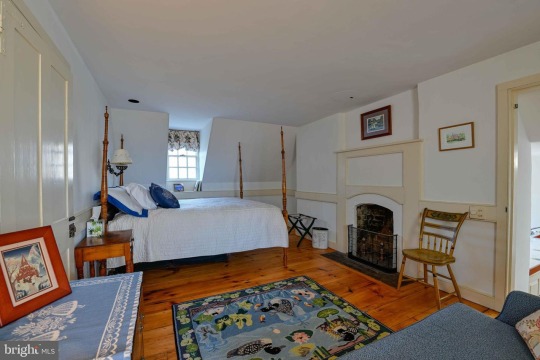
Two more of the 6 bds. are large and each has original molding and fireplaces.

One of the 7 baths. I see what they trying to do here, make the shower stall look like old wood, but it loses something in the translation.

The home has the typically steep original staff stairs.

The stairs lead to this lovely room.

Look at this wonderful surprise flanking the fireplace- a tiny library nook.

All of the original antique hardware was used.

The modernized home even has a pool room.


It’s a beautiful home.


There are 10.03 acres of beautiful gardens and an inground pool.

Plus the guest house alone is worth $650K.
https://www.redfin.com/MD/Cockeysville/714-2-Western-Run-Rd-21030/home/184568512
107 notes
·
View notes